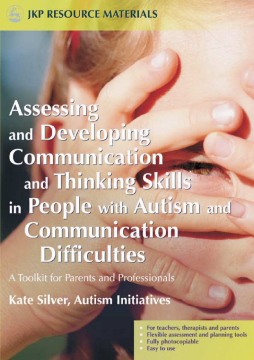
BOOK
Assessing and Developing Communication and Thinking Skills in People with Autism and Communication Difficulties
(2005)
Additional Information
Book Details
Abstract
This fully photocopiable resource offers a flexible framework for the assessment and measurement of the communication skills of children with autistic spectrum disorders (ASDs). Packed with practical assessment and planning sheets, it enables teachers, educators and other professionals to observe and record how children use and understand language, and to follow their progress over time.
The completed assessment record is an accessible summary of a child's individual communication style, identifying strengths and weaknesses and the ways in which he or she is best assisted and motivated to communicate. It focuses on how children express themselves in everyday situations - for example, how they make requests or gain attention, the words they use most frequently, and how their communication is affected by different people and places. Most importantly, it provides a diagnosis of where communication skills can be developed and improved.
Using the communication curriculum, educators can set appropriate targets, linked to work in other areas, such as literacy and science. A separate thinking skills curriculum aims to develop the skills and confidence necessary for social interaction, from making simple choices to understanding humour and abstract ideas.
Originally devised for use with children with ASDs, this toolkit is equally effective in identifying communication problems in other children, and is an invaluable resource for teachers and speech and language therapists.
Assessing and Developing Communication and Thinking Skills in People with Autism and Communication Difficulties'. These are assessment sheets, which are coded and cross-referenced with the curriculum in the next part of the book. The sheets are easily photocopy-able and therefore handy to keep as a record and to keep track of your child's progress. I found the book useful in defining what constitutes communication and in making the link between thinking skills and those required for communication.
Education Otherwise
For professionals wishing to assess communication in people with autism, this is an excellent buy. We all know how important communication is and the book does give a very clear picture of what to look for in communication development. The communication assessment and curriculum is divided into four parts: functional use of communication, expressive communication, understanding communication and social interaction - targeting the areas which most often need attention.
Good Autism Practice
Kate Silver is a Speech and Language Therapist, who qualified with a degree from the University of Newcastle upon Tyne in 1985. Since then, she has been working with people with autism of all ages, from preschoolers to adults, making autism her area of speciality in 1988. Kate has worked alongside parents, teachers, health professionals and support workers to develop the communication skills of people with autism. She has also worked with pupils in mainstream schools, MLD and SLD schools, and specialist schools for pupils with ASD. Autism Initiatives has, since 1974, sought to respond to the needs of individuals with ASD, their families and carers. They provide a range of services for adults and children in various parts of the UK. They seek to offer lifelong learning opportunities to each person, addressing the areas of communication, social interaction and flexibility of thought, throughout their daily lives, enabling each person to fulfil their personal goals. For further information about the Autism Initiatives, visit their website at www.autisminitiatives.org.
Table of Contents
| Section Title | Page | Action | Price |
|---|---|---|---|
| Prelims [Summary| Introduction] | |||
| What influences technology choice | |||
| Conclusions |
